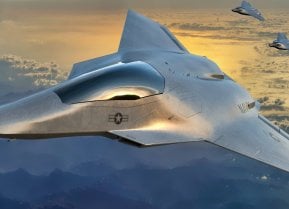F-15SE Silent Eagle Fighter Failed. The F-15EX Eagle II Was the Result
The F-15 Eagle, renowned for its 100 confirmed kills without a loss, remains a legendary fighter platform. Designed to counter the Soviet MiG-25 Foxbat, it evolved into various successful variants like the F-15E Strike Eagle. In 2009, Boeing introduced the F-15SE Silent Eagle, featuring internal weapons bays and reduced radar signature, aiming to bridge traditional attributes with emerging stealth technologies.
Summary and Key Points: The F-15 Eagle, renowned for its 100 confirmed kills without a loss, remains a legendary fighter platform. Designed to counter the Soviet MiG-25 Foxbat, it evolved into various successful variants like the F-15E Strike Eagle. In 2009, Boeing introduced the F-15SE Silent Eagle, featuring internal weapons bays and reduced radar signature, aiming to bridge traditional attributes with emerging stealth technologies.
-Despite initial interest, it was deemed inadequate for modern threats.
-Elements of the Silent Eagle were later integrated into the F-15EX II, a non-stealth fighter that excels in payload delivery and could complement fifth-generation platforms.
The F-15 Silent Eagle: The Forgotten Stealth Variant of a Legend
The F-15 Eagle is widely considered to be one of the most legendary fighter platforms to ever fly the skies. With a stunning record of 100 confirmed kills against zero losses, this American-made jet is a combat-proven fighter with an undefeated track record.
While the Eagle platform has been around for nearly five decades, some of its off-shoot variants have not been as lucky. When the F-15SE Silent Eagle was conceptualized in 2009, its designers expected the aircraft to serve as the bridge connecting traditional attributes and emerging stealth technologies in the modern era. Ultimately, however, the introduction of more advanced fifth-generation platforms would prevent the Silent Eagle from ever entering service.
The Eagle: An overview
As the arms race between the United States and the USSR was picking up speed in the 1960s, aerial innovations were perhaps at a peak. When the Soviet Union debuted its Mikoyan-Gurevich MiG-25 Foxbat fighter toward the end of the decade, U.S. officials were very concerned with the platform’s purported capabilities.
Notably, the Foxbat’s speed was perceived to be a great threat, especially after Israeli radar operators discovered a Foxbat traveling at a whopping speed of Mach 3.2 (times the speed of sound) which would have been faster than other NATO fighter jets could handle. In order to combat this competition, the “fighter mafia” led by mathematician John Boyd was created and tasked with designing a lightweight day fighter that could ensure air superiority for the service.
Big-name manufacturers including General Dynamics, North American Rockwell, McDonnell Douglas, and Fairchild all put forth fighter proposals to fulfill this objective. Ultimately, McDonnell was selected as the winner by the Air Force, resulting in the creation of the F-15 Eagle.
The Eagle was originally designed as a single variant platform, followed by the TF-15 twin-seat variant powered by the Pratt & Whitney F1000 engines. These subsequent F-15A and F-15B variants were equipped with an M61 Vulcan gun instead of the planned 25mm Ford-Philco GAU-7 cannon.
Down the line, the F-15C and F-15D modified versions were introduced, featuring the Production Eagle Package improvements which included additional internal fuel storage and increased maximum take-off weight. Armament enhancements were also incorporated on future Eagle variants, including the addition of a programmable armament control set which allowed for advanced versions of the AIM-7, AIM-9 and AIM-120A missiles.
The F-15 Strike Eagle and the F-15 Silent Eagle
Perhaps the most successful Eagle variant is the F-15E Strike Eagle, which made its maiden flight in 1986. This robust aircraft can carry a munitions load of nearly 25,000 pounds—including radar-homing and infrared-guided air-to-air missiles. Additionally, the Strike Eagle can drop the B61-12 nuclear weapon. Based on this variant’s effectiveness, Boeing recognized the need to lower the Eagle’s radar return in the hopes of convincing foreign clients that the Eagle could still be relevant even if it lacked stealth.
The Silent Eagle variant was debuted by Boeing in 2009, featuring several key changes outlined by Sandboxx News: “The result was an F-15 that looked quite a bit like a stripped-down old one, but with some very important changes. Most notably, the 750-gallon conformal fuel tanks were removed from the fighter’s fuselage and replaced with new conformal weapons bays (CWBs) that were very similar in external design to the fuel tanks they replaced. This allowed the Silent Eagle to carry its firepower internally like 5th generation fighters, eliminating the radar return created by external munitions while maintaining a similar aerodynamic profile to the Strike Eagle that had already proven itself in service.”
Based on these impressive specs, several foreign nations were initially interested in procuring the Silent Eagle variant—including South Korea and Saudi Arabia. Ultimately, however, the aircraft was just not considered capable enough to survive in emerging threat climates.
Despite the variant’s cancellation, some of its components and designs have been incorporated into the latest Eagle iteration. The F-15EX II does not compromise on the payload for survivability as it can notably shoot farther than any of its counterparts, making it a potential critical asset to the USAF. For this reason, many analysts consider the Eagle II to be an enhanced and modern version of the proposed Silent Eagle fighter. Like the latter platform, the Eagle II lacks stealth.
However, this fighter could remain relevant flying alongside fifth-generation platforms or even the Air Force’s upcoming Next Generation Air Dominance (NGAD) fighter.
About the Author: Maya Carlin
Maya Carlin, National Security Writer with The National Interest, is an analyst with the Center for Security Policy and a former Anna Sobol Levy Fellow at IDC Herzliya in Israel. She has by-lines in many publications, including The National Interest, Jerusalem Post, and Times of Israel. You can follow her on Twitter: @MayaCarlin.
Image Credit: Creative Commons.


